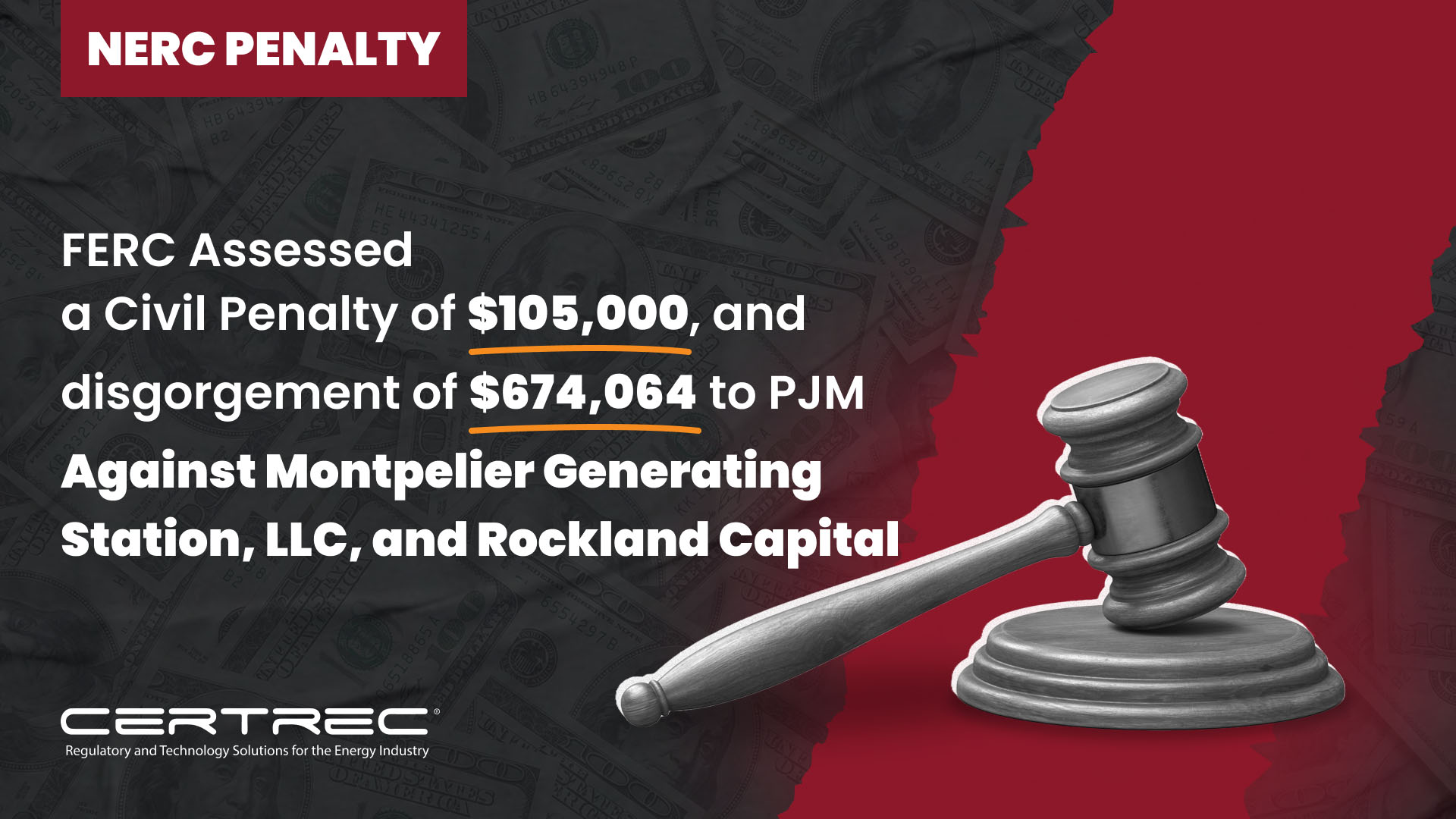Facility Ratings Not Consistent With Facility Ratings Methodology (FRM) Results in $82,000 Penalty
Summary of NERC Penalties
REGION | WHEN? | ENTITY
| REASON | VIOLATIONS | COMPLIANCE AREA
| PENALTY AMOUNT |
|---|---|---|---|---|---|---|
NERC | Quarter 1 06/18/07- 02/04/20 | MidAmerican Energy Company (MEC) | Affected jumper components and failed to consider industry standards for substation bus design (IEEE Std. 605-2008) and for reducing equipment loss of life (IEEE Std. C57.19) as required by its FRM | Facilities Design, Connections, and Maintenance (FAC) Standard | FAC-009-1 R1 | $82k |
Cause Determination
The cause of the noncompliance was the Entity’s (MEC) inadequate process for reviewing ratings and facility components. For its affected jumper components, MEC failed to consider industry standards for substation bus design (IEEE Std. 605-2008) and for reducing equipment loss of life (IEEE Std. C57.19) as required by its FRM. Additionally, for its other affected Facility components, MEC failed to update the primary drawings used for FRs after changes to the equipment were made in the field.
The noncompliance began on June 18, 2007, the date the standard became enforceable, and ended on February 4, 2020, when the MEC corrected all of the component and FRs.
Extent of Condition/Risk Determination
This violation posed a moderate risk and did not pose a serious or substantial risk to the reliability of the bulk power system. Operating a Facility at a rating that is above the rating of the most limiting element could result in damage to the limiting element and possible failure, leading to an outage of the Facility. Upon review of the EOC and other information provided by MEC, MRO determined the risk is moderate. MEC identified 89 transmission lines with Facility component rating errors that resulted in a FR change. Of the 89 Facilities, 62 had erroneous FRs that were higher than the actual rating of the most limiting element, resulting in a FR decrease when the error was corrected. Six of the 62 Facilities with ratings decreases were 345-kV Facilities. The most significant of these six was a Facility with a 5% summer normal and 20% winter normal rating decrease. Additionally, the duration of the issues was over 12 years. However, MRO determined that the issue did not pose a serious or substantial risk to the BPS. Of the six years of historical power flows and four years of temperature data (for dynamic ratings) that were reviewed, none of the flows exceeded any of the 89 adjusted FRs, limiting the actual risk posed to the BES. Also, 55 of the 62 FR decreases were caused by jumper component ratings issues. The jumper ratings used by MEC allowed for operation up to 100 degrees Celsius and were consistent with the manufacturer documentation for the conductor. However, the MEC’s FRM required consideration of industry standards for substation bus design (IEEE Std. 605-2008) and for reducing equipment loss of life (IEEE Std. C57.19). The consideration of those two industry standards resulted in a reduction of the operating temperature limit to 90 degrees Celsius. The risk associated with these 55 ratings decreases is limited as the jumper conductor ratings were valid per manufacturer specifications. The jumper issue was the cause of three of the six 345-kV facility ratings decreases. Further, the 27 FR increases did not pose any risk of overloading the Facilities as they resulted in overly conservative operation of the Facilities. No harm is known to have occurred.
Enforcement
MRO considered the Entity’s compliance history and determined that there were no relevant instances of noncompliance. MRO provided mitigating credit for cooperation, self-reporting, admission, settlement, and the internal compliance program. A penalty of $82,000 was assessed.
Mitigation
To mitigate this violation, MEC:
- adjusted all FRs changes for BES facilities with its Control Center and Reliability Coordinator;
- enhanced substation engineering quality assurance review checklists were developed and complete;
- trained personnel on the enhanced quality assurance review checklist;
- completed historical documentation reviews for all remaining BES Transmissions Facilities;
- completed nameplate reviews for all 161kV and 345kV substations;
- completed pre-commission checklists to identify and actively communicate design changes during construction; and
- instituted annual field reviews and completed reviews for 2018 and 2019.
About Certrec:
Certrec is a leading provider of regulatory compliance solutions for the energy industry with the mission of helping ensure a stable, reliable, bulk electric supply. Since 1988, Certrec’s SaaS applications and consulting expertise have helped hundreds of power-generating facilities manage their regulatory compliance and reduce their risks.
Certrec’s engineers and business teams bring a cumulative 1,500 years of working experience in regulatory areas of compliance, engineering, and operations, including nuclear, fossil, solar, wind facilities, and other Registered Entities generation and transmission.
Certrec has helped more than 200 generating facilities establish and maintain NERC Compliance Programs. We manage the entire NERC compliance program for 80+ registered entities in the US, Canada, and Mexico that trust us to decrease their regulatory and reputational risk. Certrec is ISO/IEC 27001:2013 certified and has successfully completed annual SOC 2 Type 2 examinations.
For press and media inquiries, please contact marketing@certrec.com.
Share
REGION | WHEN? | ENTITY | REASON | VIOLATIONS | COMPLIANCE AREA | PENALTY AMOUNT |
|---|---|---|---|---|---|---|
NERC | Quater 1 01/01/16- 05/15/17 | SPP | No sufficient alarm management in its Real-time Contingency Assessment (RTCA) system | Interconnection Reliability Operations and Coordination (IRO) Standard | IRO-002-4 R4.6 | $280k |








